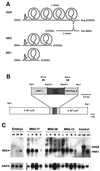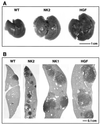Disassociation of met-mediated biological responses in vivo: the natural hepatocyte growth factor/scatter factor splice variant NK2 antagonizes growth but facilitates metastasis
- PMID: 10688652
- PMCID: PMC110822
- DOI: 10.1128/MCB.20.6.2055-2065.2000
Disassociation of met-mediated biological responses in vivo: the natural hepatocyte growth factor/scatter factor splice variant NK2 antagonizes growth but facilitates metastasis
Abstract
Hepatocyte growth factor/scatter factor (HGF/SF) stimulates numerous cellular activities capable of contributing to the metastatic phenotype, including growth, motility, invasiveness, and morphogenetic transformation. When inappropriately expressed in vivo, an HGF/SF transgene induces numerous hyperplastic and neoplastic lesions. NK1 and NK2 are natural splice variants of HGF/SF; all interact with a common receptor, Met. Although both agonistic and antagonistic properties have been ascribed to each isoform in vitro, NK1 retains the full spectrum of HGF/SF-like activities when expressed as a transgene in vivo. Here we report that transgenic mice broadly expressing NK2 exhibit none of the phenotypes characteristic of HGF/SF or NK1 transgenic mice. Instead, when coexpressed in NK2-HGF/SF bitransgenic mice, NK2 antagonizes the pathological consequences of HGF/SF and discourages the subcutaneous growth of transplanted Met-containing melanoma cells. Remarkably, the metastatic efficiency of these same melanoma cells is dramatically enhanced in NK2 transgenic host mice relative to wild-type recipients, rivaling levels achieved in HGF/SF and NK1 transgenic hosts. Considered in conjunction with reports that in vitro NK2 induces scatter, but not other activities, these data strongly suggest that cellular motility is a critical determinant of metastasis. Moreover, our results demonstrate how alternatively structured ligands can be exploited in vivo to functionally dissociate Met-mediated activities and their downstream pathways.
Figures








Similar articles
-
NK1, a natural splice variant of hepatocyte growth factor/scatter factor, is a partial agonist in vivo.Mol Cell Biol. 1998 Mar;18(3):1275-83. doi: 10.1128/MCB.18.3.1275. Mol Cell Biol. 1998. PMID: 9488442 Free PMC article.
-
Constitutive c-Met signaling through a nonautocrine mechanism promotes metastasis in a transgenic transplantation model.Cancer Res. 2002 May 15;62(10):2951-6. Cancer Res. 2002. PMID: 12019177
-
Hepatocyte growth factor/scatter factor induces feedback up-regulation of CD44v6 in melanoma cells through Egr-1.Cancer Res. 2003 Apr 1;63(7):1576-82. Cancer Res. 2003. PMID: 12670907
-
Structural basis of MET receptor dimerization by the bacterial invasion protein InlB and the HGF/SF splice variant NK1.Biochim Biophys Acta. 2013 Oct;1834(10):2195-204. doi: 10.1016/j.bbapap.2012.10.012. Epub 2012 Oct 31. Biochim Biophys Acta. 2013. PMID: 23123275 Review.
-
Signalling by HGF/SF and Met: the role of heparan sulphate co-receptors.Biochem Soc Trans. 2006 Jun;34(Pt 3):414-7. doi: 10.1042/BST0340414. Biochem Soc Trans. 2006. PMID: 16709175 Review.
Cited by
-
The hepatocyte growth factor isoform NK2 activates motogenesis and survival but not proliferation due to lack of Akt activation.Cell Signal. 2016 Aug;28(8):1114-23. doi: 10.1016/j.cellsig.2016.05.012. Epub 2016 May 17. Cell Signal. 2016. PMID: 27224506 Free PMC article.
-
Targeting the HGF-cMET Axis in Hepatocellular Carcinoma.Int J Hepatol. 2013;2013:341636. doi: 10.1155/2013/341636. Epub 2013 Mar 31. Int J Hepatol. 2013. PMID: 23606971 Free PMC article.
-
SF/HGF-c-Met autocrine and paracrine promote metastasis of hepatocellular carcinoma.World J Gastroenterol. 2001 Dec;7(6):816-20. doi: 10.3748/wjg.v7.i6.816. World J Gastroenterol. 2001. PMID: 11854908 Free PMC article.
-
Hepatocyte Growth Factor Isoforms in Tissue Repair, Cancer, and Fibrotic Remodeling.Biomedicines. 2014 Nov 5;2(4):301-326. doi: 10.3390/biomedicines2040301. Biomedicines. 2014. PMID: 28548073 Free PMC article. Review.
-
Lifetime exposure to a soluble TGF-beta antagonist protects mice against metastasis without adverse side effects.J Clin Invest. 2002 Jun;109(12):1607-15. doi: 10.1172/JCI15333. J Clin Invest. 2002. PMID: 12070308 Free PMC article.
References
-
- Bardelli A, Basile M L, Audero E, Giordano S, Wennstrom S, Menard S, Comoglio P M, Ponzetto C. Concomitant activation of pathways downstream of Grb2 and PI 3-kinase is required for MET-mediated metastasis. Oncogene. 1999;18:1139–1146. - PubMed
-
- Bellusci S, Moens G, Gaudino G, Comoglio P, Nakamura T, Thiery J-P, Jouanneau J. Creation of a hepatocyte growth factor/scatter factor autocrine loop in carcinoma cells induces invasive properties associated with increased tumorigenicity. Oncogene. 1994;9:1091–1099. - PubMed
-
- Bladt F, Riethmacher D, Isenmann S, Aguzzi A, Birchmeier C. Essential role for the c-met receptor in the migration of myogenic precursor cells into the limb bud. Nature. 1995;376:768–771. - PubMed
-
- Bottaro D P, Rubin J S, Faletto D L, Chan A M, Kmiecik T E, Vande Woude G F, Aaronson S A. Identification of the hepatocyte growth factor receptor as the c-met proto-oncogene product. Science. 1991;251:802–804. - PubMed
-
- Castagnino P, Soriano J V, Montesano R, Bottaro D P. Induction of tissue inhibitor of metalloproteinases-3 is a delayed early cellular response to hepatocyte growth factor. Oncogene. 1998;17:481–492. - PubMed
MeSH terms
Substances
LinkOut - more resources
Full Text Sources
Other Literature Sources
Molecular Biology Databases
Miscellaneous
